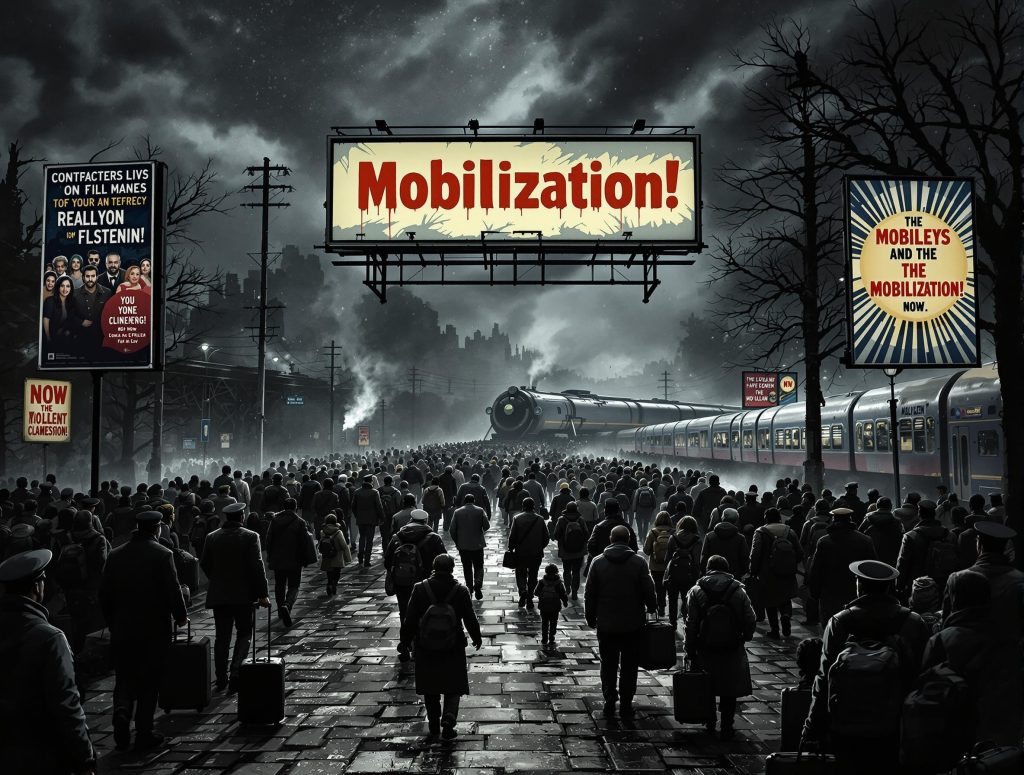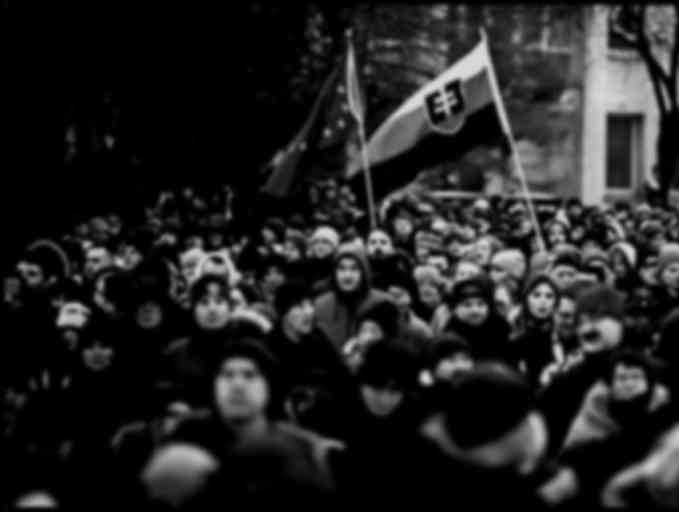Mobilization! #Czechoslovakia#mobilization#modern mobilization#USA#WWI
The president and a few politicians allowed themselves to be drafted, put on military uniforms, took an oath, and are mobilizing the public for service in the armed forces, or at least in their reserves. Should we be afraid?
#Czechoslovakia #mobilization #modern mobilization #USA #WWI
You can listen this article in a form of podcast:
https://www.podbean.com/ew/pb-smb8q-1922dd1 or here Mobilisation! – Pavel Macko – Bezpečnosť, Technológie, Stratégie

Coalition politicians mobilized people against COVID measures and corruption investigations. It brought them to power. Have we experienced a real mobilization? Most people would think that we were lucky and haven’t experienced any mobilization firsthand. But if you were ten or more years old in 2000, you did experience a mobilization. A different kind than military.
With the arrival of the millennium, there was a worldwide mobilization of forces and a major software and computer systems cleanup to handle the transition to four-digit year display in computer systems (the so-called Y2K mobilization).
Computers stored only the last two digits of the year in dates. If you had 98, the system added 19 and the year in the date was 1998. But how would systems interpret 00? Mostly as 1900. The world had a problem. Although Slovakia wasn’t as digitized as the West, there could still have been problems in banking, public services, and similar areas.
Unlike military mobilization, this one was led by civilian IT experts, companies, and officials. Governments and international organizations only coordinated it. Thanks to joint efforts, the transition to the new millennium was problem-free. The mobilization also resulted in increased computer production and renovation of old equipment.
What is mobilization?
Y2K mobilization is considered a model of proactive risk management. It turned out that mobilization doesn’t require tanks or soldiers – it can be about information, coordination, and foresight. When we talk about mobilization at the state level, we typically mean concentrated efforts to avert a major, potentially existential threat, or to minimize its impacts.
Mobilization – whether military, civil, digital, or disaster-related – is always about preparing the right people, resources, and systems for action. Every mobilization must have a clear purpose. It’s a response to a threat, crisis, or opportunity. Mobilization of healthcare, security, and logistics capacities during the COVID pandemic was also an opportunity to activate the scientific research base. Mobilization can be:
▪️military
▪️ civil
▪️technical
▪️political
Speed and coordination
Mobilization isn’t about standard procedures; we demand rapid deployment of people and resources. Mobilization shows us how strong and effective the state is. Not the number of police officers or hand-holding citizens in everyday life. During a crisis, it’s not about what comes to someone’s mind. Centralized command with synchronized action across sectors is needed.
Communication with the public is a key condition for success, especially for non-military threats. People must receive transparent information about why mobilization is taking place. They need to be reassured to reduce panic and ensure their cooperation.
Without prepared resources, all effort is futile. Infrastructure, logistics, supplies, personnel must be available from the start. Emergency plans and backup options allow them to respond flexibly. The legitimacy of extraordinary measures and the authority of those who order them are also important. Mobilization requires legal support and a public mandate. It often involves executive decision-making or emergency powers.
Without the participation of citizens, experts, and organizations that play key roles, it would be just an intellectual exercise. Participation can be voluntary, or people can be officially drafted or professionally assigned. Efficiency and discipline require a detailed plan, synchronization of activities, clear tasks, and rapid execution. Even civil mobilizations are similar to war preparedness. All activities must be monitored and managed.
Monitoring and adaptability are also important for successful mobilization. This gives leaders feedback to adjust strategy on the go. This cannot be achieved without transparent reporting of results, failures, and successes.
This is exactly what we expected from government commissioner Kotlár. Instead of a serious analysis of processes and state crisis management during the pandemic, we got metaphysical nonsense from an orthopedist with a child’s microscope. This is almost a guarantee that this government would totally fail in a similar mobilization.
From Clausewitz to drones
The modern concept of mobilization took shape only in the 19th century. Clausewitz, in his timeless theory of war, came up with the famous statement that „war is the continuation of politics by other means“ and is always subordinate to political goals. In his understanding, war is a dynamic interplay of:
▪️ violence and passion (ordinary people)
▪️ chance and probability (the army)
▪️ rational calculation (the government)
Using this „remarkable trinity,“ he explains war as a social and political phenomenon, not just a military one.
Clausewitz came up with the concept of „absolute war.“ This might suggest that he is also the author of mobilization. Clausewitz never used this term. However, his theory of war is the philosophical foundation for mobilization. He emphasized that war requires complete social engagement, which mobilization later defined. The term „mobilization“ appeared only in the 1850s and was first used to designate Prussian military preparations. It reflects the idea that war is shaped by political will, national emotions, and strategic calculation.
Mobilization is Clausewitz’s theory in action. It’s about transforming political intent into military power through social effort. Let’s look at how mobilization evolved during the First and Second World Wars, up to today’s hybrid forms, including cyber and cognitive mobilization.
The First World War brought the birth of systematic mobilization
From June 28, 1914 (the assassination in Sarajevo) to August 6 (the first major battle), only 39 days passed. The world went from peace to global war in just over a month. This rapid escalation is often called the „July Crisis“ and is a textbook example of how diplomacy, alliances, and miscalculations can escalate into disaster. Mobilization was declared in Austria-Hungary on July 25, 1914. Less than two weeks later, fighting had already begun.
For the first time, entire national economies were redirected to war. Governments created central planning boards to allocate raw materials, labor, and transportation. Experiences from the war led to the systematization of mobilization preparations. Nations learned that mobilization had been reactive and chaotic. The war revealed the need for planning and coordination between ministries and agencies.
The Second World War brought the peak of total war mobilization
The international situation deteriorated gradually as the Nazis consolidated their power in Germany. By 1938, the world was at a breaking point. Mobilization plans were elaborated in detail, institutions were prepared, and the population was motivated. Czechoslovakia was one of the first to experience mobilization for real. The government carried out two mobilizations in 1938.
The first was a partial mobilization on May 20 during the so-called May crisis, when reports of German troop concentrations near the borders appeared. About 180,000 reservists were called up, expanding the army to about 380,000 men. The State Defense Guard (SOS) was also activated, which began to occupy border areas. After the situation calmed down, mobilization was canceled on June 13.
After Hitler presented an ultimatum to cede part of the territory, Jan Syrový’s government declared general mobilization on September 23 at 22:00. 1,250,000 men were called up. The mobilization proceeded quickly and successfully. Within 24 hours, 60% of reservists reported. The army used a 1936 plan to quickly mobilize:
▪️350 tanks
▪️5,000 artillery pieces
▪️950 military aircraft
▪️217,000 horses
▪️26,000 vehicles
▪️5,000 motorcycles
Soldiers were to bring food for two days, cutlery, cleaning supplies, and a backpack.
The speed and efficiency of mobilization was unprecedented, even by today’s standards. After the declaration of general mobilization, society united. People were ready to defend the republic, although they knew they were facing overwhelming odds. Spontaneous gatherings were held in cities, and banners proclaimed: „We won’t give up an inch of the republic!“ or „Czechoslovakia will defend itself!“. Radio served as a bonding agent. Residents sat by their radios, waiting for orders and news. People waited for a clear decision, and while many cried, others rejoiced that a decision had finally been made.
American mobilization as a key to victory
After the US was drawn into the war, mobilization also took place across the ocean. The Americans further refined the concept of mobilization. It wasn’t just about immediate action as in Czechoslovakia, but about long-term mobilization of all national resources. This was also one of the important factors for the final victory over fascism and Japanese imperialism. The USA long-term mobilized resources for its European allies as well.
There was a fundamental revision of the economy. The USA transformed into a planned war economy:
▪️Civilian factories were rebuilt to produce tanks, aircraft, and ammunition
▪️The federal government financed most industrial investments
▪️It often owned facilities and leased them to private companies
▪️There was a significant managed expansion of the workforce
▪️Massive work shifts were introduced
▪️Women and minorities entered the workforce in record numbers
▪️Agencies such as the War Manpower Commission coordinated its allocation
The war showed that government-led industrial transformation is possible and effective.
Mobilization during the Cold War
During the Cold War, mobilization was perceived as part of deterrence. The main goal was to secure and demonstrate strategic readiness. Mobilization planning shifted from implementation to preparedness. Countries introduced:
▪️Long-term storage of critical materials (e.g., rubber, rare earths)
▪️Maintaining emergency production capacity for defense supply chains
How useful would these be today, when we can’t restart production even after more than three years since the Russian invasion of Ukraine!
Technological mobilization was also taking place. Emphasis was placed on research and development and innovation (e.g., DARPA). Technologies became an element of deterrence. Mobilization expanded to education, infrastructure, and scientific policy. Mobilization planning was embedded in national security strategy.
Current challenges require fragmented mobilization
The COVID-19 pandemic revealed gaps in supply chain resilience and coordination between the public and private sectors. Climate change is an epochal matter and requires long-term civil mobilization with a shift toward sustainability, decarbonization, and adaptive infrastructure.
The war in Ukraine and hybrid threats bring new dimensions to the view of mobilization. Ukraine’s defense shows how civil society, technology startups, and decentralized logistics can mobilize under fire. Western countries face challenges in mobilizing national will. This raises the need to revise mobilization theory.
From trenches to algorithms: mobilization change
Experiences from Ukraine, our inability to keep pace with a weaker Russia in military production, and future challenges force us to comprehensively reassess our approach to mobilization. While we have almost forgotten about mobilization, today we must simultaneously address several conceptual problems. We need to answer basic questions:
▪️„What to mobilize and why?“
▪️„Mobilization or modernization?“
Researchers call for a revival of the mobilization economy. Not just for war, but also for existential threats. Mobilization now includes information warfare, cyber resilience, and economic deterrence.
At the NATO summit, allies agreed to significantly increase defense spending. The real increase in hard military spending to 3.5% of GDP and total spending to 5% of GDP is not just an effort to please President Trump. The numbers come from military planners‘ data on the minimum military capabilities that are supposed to guarantee our deterrence and ability to defend ourselves.
Maintaining national will
In a long conflict, victory is rarely achieved by firepower alone. It requires mobilization of national will. It’s about combining:
▪️military readiness
▪️civil resilience
▪️social cohesion
The concept of total defense transcends traditional battlefield boundaries and integrates every layer of society into the defense architecture. We must be able to conduct combat operations and protect the entire territory simultaneously. Modern war is decentralized. Territorial defense blurs the boundaries between soldier and citizen and promotes a culture in which defense is a shared responsibility.
Infrastructure protection and civil defense
A separate chapter is infrastructure protection and civil defense. Energy networks, transportation hubs, and communication networks are increasingly vulnerable in hybrid warfare. We need to plan for resilience. Countries invest in:
▪️redundant systems
▪️cyber resilience
▪️rapid repairs
All this to withstand long-term disruption of their function.
Slovak specifics and weaknesses
Slovakia might have problems maintaining the determination to invest in defense and defend the homeland. Deep divisions persist in society regarding:
▪️the war in Ukraine
▪️Russian influence
▪️internal governance
We lack volunteer networks or a culture of civic resistance. Energy dependence on Russia and inadequately funded infrastructure could lead to collapse under constant pressure. Cyber attacks, disinformation, and energy sabotage could disrupt cohesion without a single shot fired. We would have difficulty replicating the Ukrainian model of total defense without fundamental reforms in civic engagement, infrastructure, and political unity.
Mobilization or modernization?
As Europe increases defense spending in response to renewed geopolitical threats, a critical question arises: Are we mobilizing for past wars or preparing for future conflicts? Many current spending plans still favor older platforms and traditional procurement cycles.
The sharp increase in spending also brings strategic risks:
▪️Investing in outdated systems risks irrelevance on battlefields saturated with drones and cyber capabilities
▪️One-time spending spikes can undermine research and development, dual-use technologies, and startup ecosystems
Paradigm shift
To avoid mobilizing for the wrong war, defense spending must prioritize:
▪️modular, scalable systems over older platforms
▪️investments in artificial intelligence, quantum, cyber, and space capabilities
▪️support for civil-military integration including territorial defense and infrastructure resilience
NATO or EU mobilization will be joint, but sustainability must also be local. We need to promote joint procurement, interoperability, and industrial sovereignty. This is homework for policymakers and politicians.
Mobilization is no longer just about tanks and soldiers. It’s about systems, societies, and strategic purpose. In today’s threat environment, the question is not just how we mobilize, but why and for what we mobilize. For deterrence, the concept of mobilization must have signaling capability to the adversary and demonstrate our credible determination.
Deterrence is not just about having power. It’s about showing that you can use it effectively and sustainably. For resilience, ensuring continuity and recovery of state operations is critical. The most important mobilization assets are:
▪️civil society
▪️volunteer networks
▪️territorial defense
▪️psychological preparedness
▪️critical infrastructure
▪️state management capacity
▪️private sector
Conclusion: Mobilization as a strategic act
Mobilization is not just a budget line in public finances. It is a strategic act of national existential purpose. To be effective, it must be:
▪️aligned with modern threat paradigms
▪️integrating deterrence and resilience
▪️engaging the whole society, not just the army
Despite our constitutional officials putting on uniforms and training with weapons in hand, immediate military mobilization is not imminent. We have a few years to reconsider our concepts, change laws, build capacities, and especially trust.
The next mobilization that we won’t avoid will be political mobilization to maintain the democratic constitutional system and our continued membership in the EU and NATO. But if we fail in this, we can forget about the rest. Our fate will be determined by others who won’t take our national interests and goals into account.
NASPAŤ
